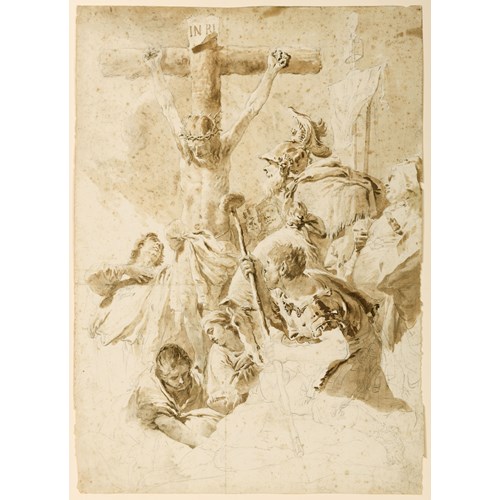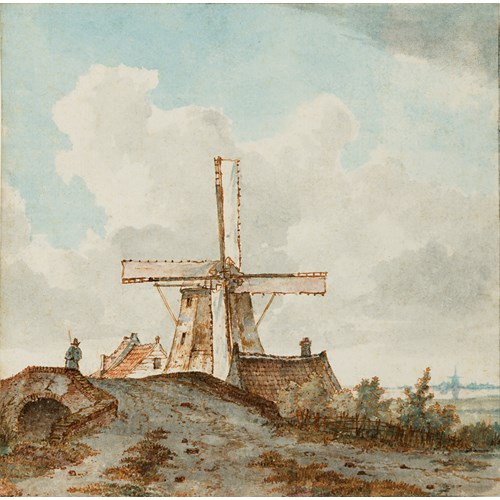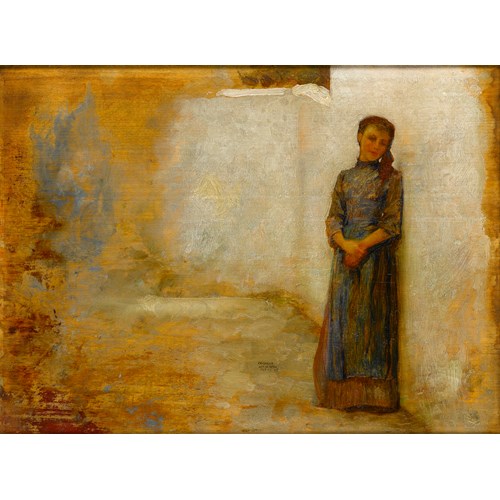Jean Honoré FRAGONARD
A Statue in a Garden
Medium Pen, brush and brown ink and brown and grey wash
Dimension 17.3 x 23.3 cm (6³/₄ x 9¹/₈ inches)
Drawn with incredible freedom in brush and wash, this atmospheric landscape drawing is likely to have been made during or shortly after Fragonard’s summer at Tivoli in 1760. As one scholar has described the drawing, ‘The shadowy, diffuse figures in the foreground seem to be worshipping, or at least contemplating, the statue of a female figure set on a pedestal in a niche or grotto. The latter is placed at the end of a vaguely defined structure, natural or man-made, which compounds the enigmatic quality of the scene.’
The present sheet may be included among a handful of small-scale, early landscape drawings in pen and wash by the artist, all datable to around 1760, which ‘represent some of Fragonard’s earliest independent experiments with wash techniques, in which he is a draftsman still devoted to line, but at the same time he is discovering a natural and instinctive expression through atmosphere and color.’ Executed during the first of Fragonard’s two stays in Rome, these drawings share a similar use of ink and wash over a black chalk underdrawing.
Other stylistically comparable small landscape drawings by Fragonard of c.1760 include A Temple in a Garden in the collection of the Peabody Institute, on loan to the Baltimore Museum of Art, a Scene in a Park in the Cleveland Museum of Art and a Garden in an Italian Villa in the collection of Jean Bonna in Geneva. Two further drawings from this group are A Wooded Landscape with Figures on a Bluff, formerly in the collection of Dr. and Mrs. Francis Springell and sold at auction in 1986, and A Couple in a Park, at one time in the collections of Camille Groult and Jacques Bacri and recently sold at auction in Paris. A somewhat more sketchy Italianate landscape drawing in pen and wash of the same period was on the French art market in 1986.
As Eunice Williams has written of the Baltimore and Cleveland drawings noted above, in terms that apply equally to the present sheet and others from of this same group of small pen and wash landscapes, ‘The scale and decorative concept [of these drawings] may seem far removed from Fragonard’s great sanguine landscapes made in 1760 during his stay at the Villa d’Este; but these works, regardless of size, share related ideas of compositional structure. The unifying principles are surprisingly classical in their emphasis on formal balance and deliberate contrasts and on clearly defined space. Depth is usually limited or blocked, and lateral space is contained by framing devices such as trees or architectural features. Staffage provides a sense of scale and animation. The sanguine series made at the Villa d’Este records identifiable sites, while the group of small, early wash drawings…may depend more on the artist’s invention. It is significant that they both reflect traditional principles of composition which Fragonard had learned in his academic training from Vanloo and Natoire, and from his own study of artists of the past.’
Pen, brush and brown ink and brown and grey wash, over traces of an underdrawing in black chalk, with framing lines in brown ink.
Medium: Pen, brush and brown ink and brown and grey wash
Signature: Inscribed frago at the lower left.
Dimension: 17.3 x 23.3 cm (6³/₄ x 9¹/₈ inches)
Provenance: Galerie Cailleux, Paris, by 1981
Juan de Beistegui, Château de Groussay, Montfort-l’Amaury, by 1987
His sale, Montfort-l’Amaury, Poulain Le Fur and Sotheby’s, 2 June 1999, lot 64
Pandora Old Masters, New York, in 2004
Private collection.
Literature: Pinkney L. Near, Three Masters of Landscape: Fragonard, Robert, and Boucher, exhibition catalogue, Richmond, 1981, p.23, no.10; Jean Cailleux and Marianne Roland Michel, Rome 1760-1770: Fragonard, Hubert Robert et leurs Amis, exhibition catalogue, Paris, 1983, unpaginated, no.22; Marianne Roland Michel, Aspects de Fragonard: Peintures – Dessins – Estampes, exhibition catalogue, Paris, 1987, unpaginated, no.44; New York, Pandora Old Masters, Recent Acquisitions, 2004, pp.24-25, unnumbered; Emmanuelle Brugerolles, ed., Suite française: Dessins de la collection Jean Bonna, exhibition catalogue, Paris and Geneva, 2006-2007, p.203, under no.47 (entry by Diederik Bakhuÿs); Sarah Catala, Fragonard: Collections privées, exhibition catalogue, Paris, 2022, p.96, no.39.
Exhibition: Richmond, Virginia Museum of Fine Arts, Three Masters of Landscape: Fragonard, Robert, and Boucher, 1981, no.10; Paris, Galerie Cailleux, Rome 1760-1770: Fragonard, Hubert Robert et leurs Amis, 1983, no.22; Paris, Galerie Cailleux, Aspects de Fragonard: Peintures – Dessins – Estampes, 1987, no.44; Paris, Galerie Éric Coatalem, Fragonard: Collections privées, 2022, no.39.
More artworks from the Gallery




_T638637429008849335.jpg?width=500&height=500&mode=pad&scale=both&qlt=90&format=jpg)




